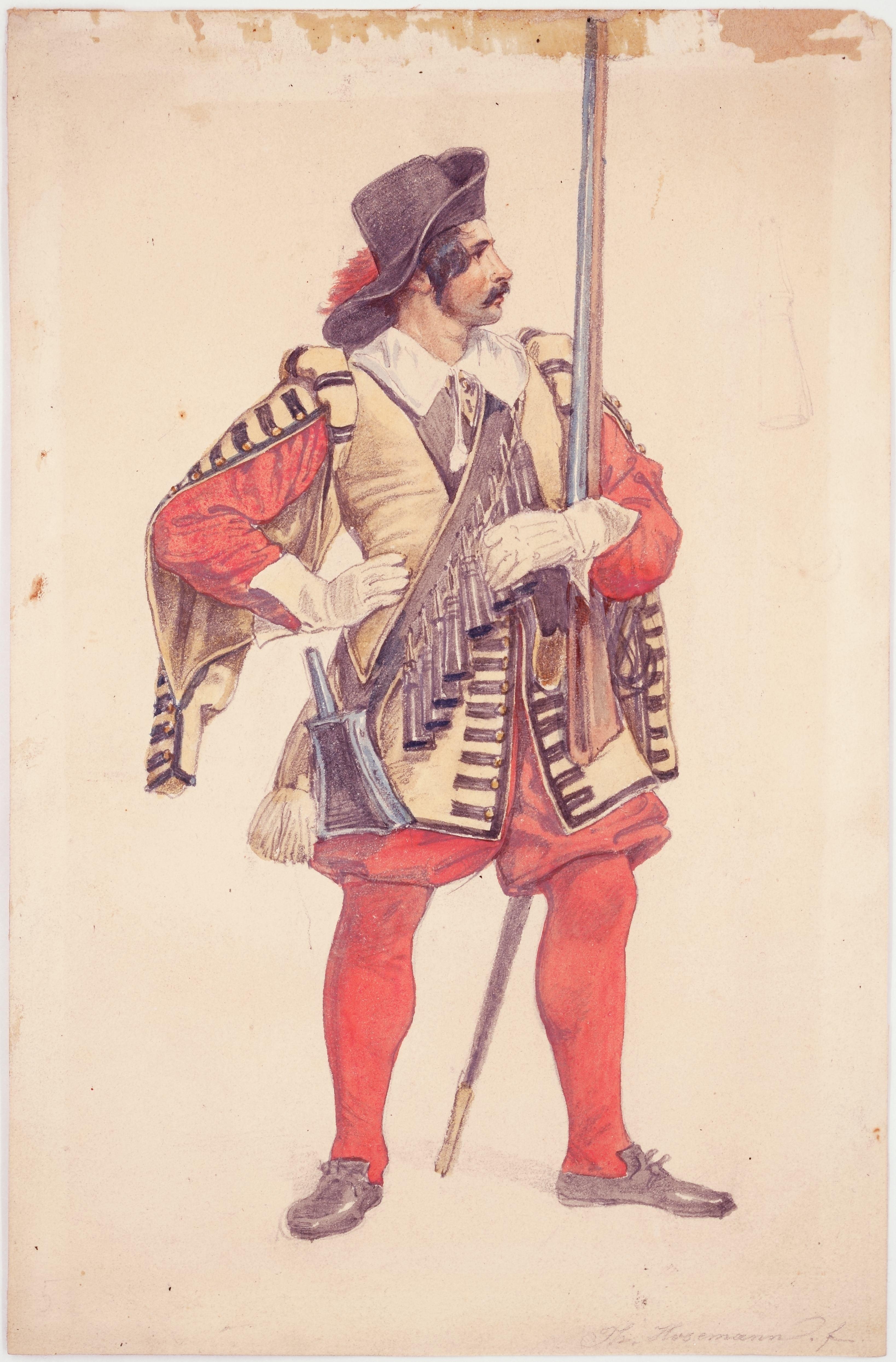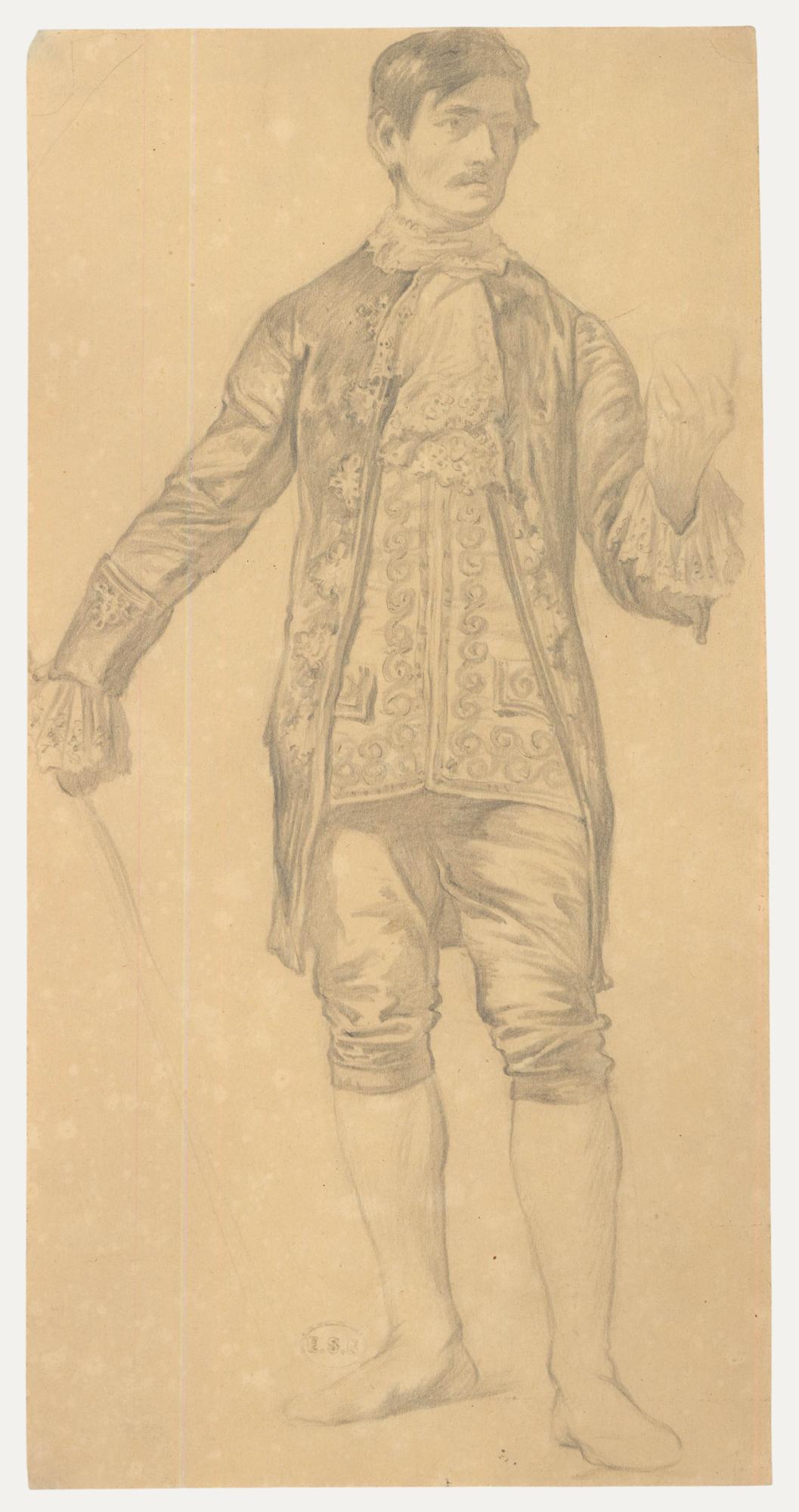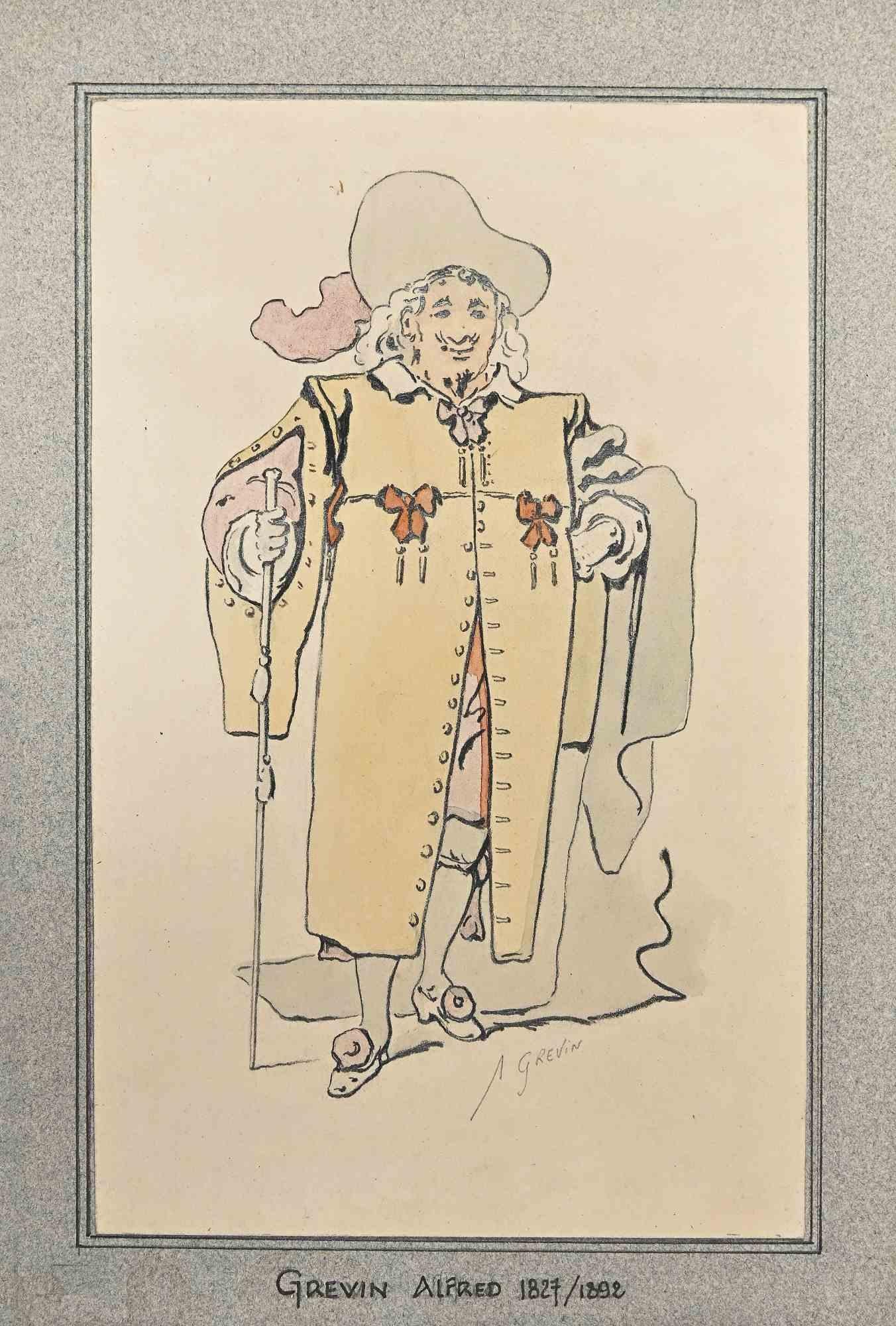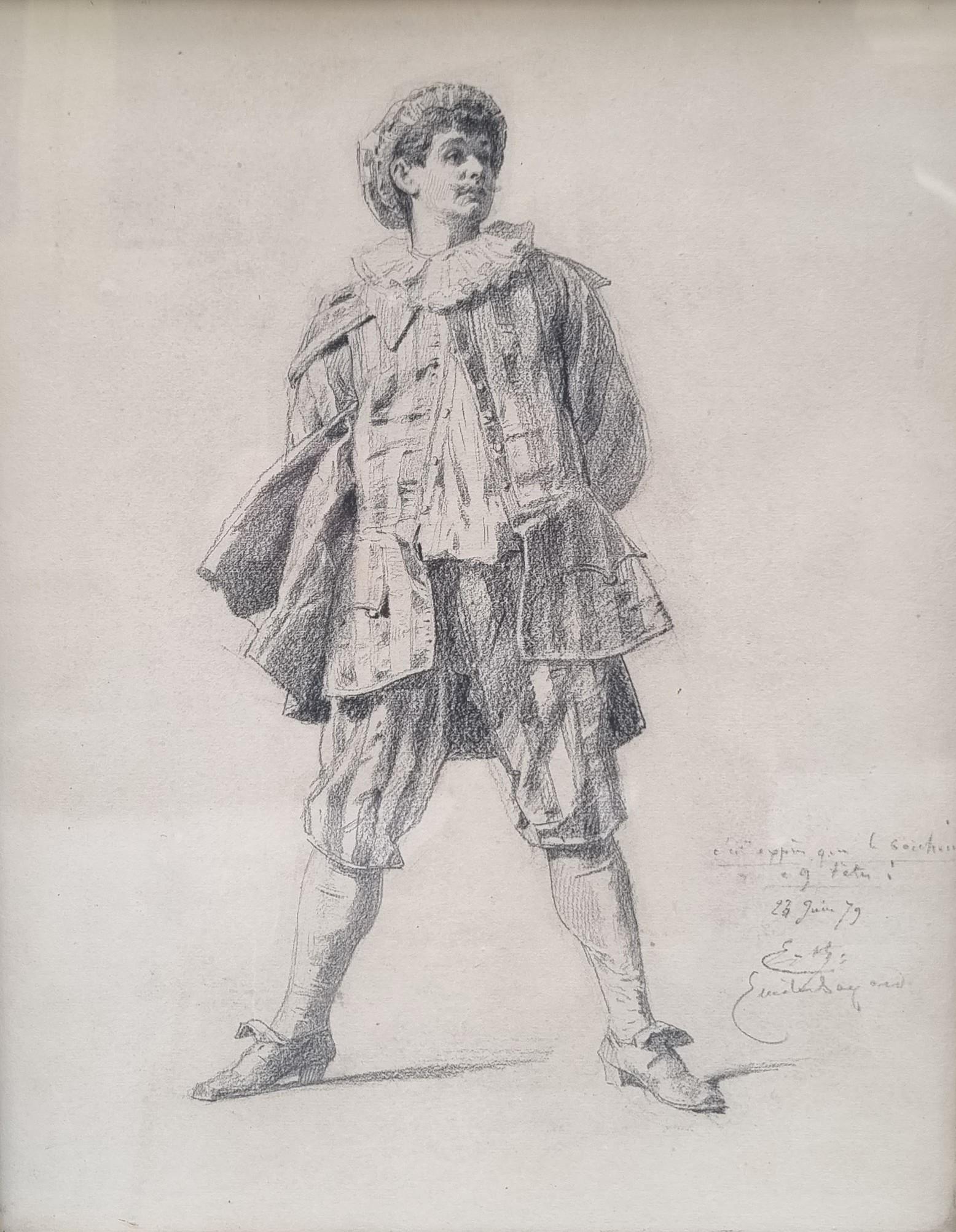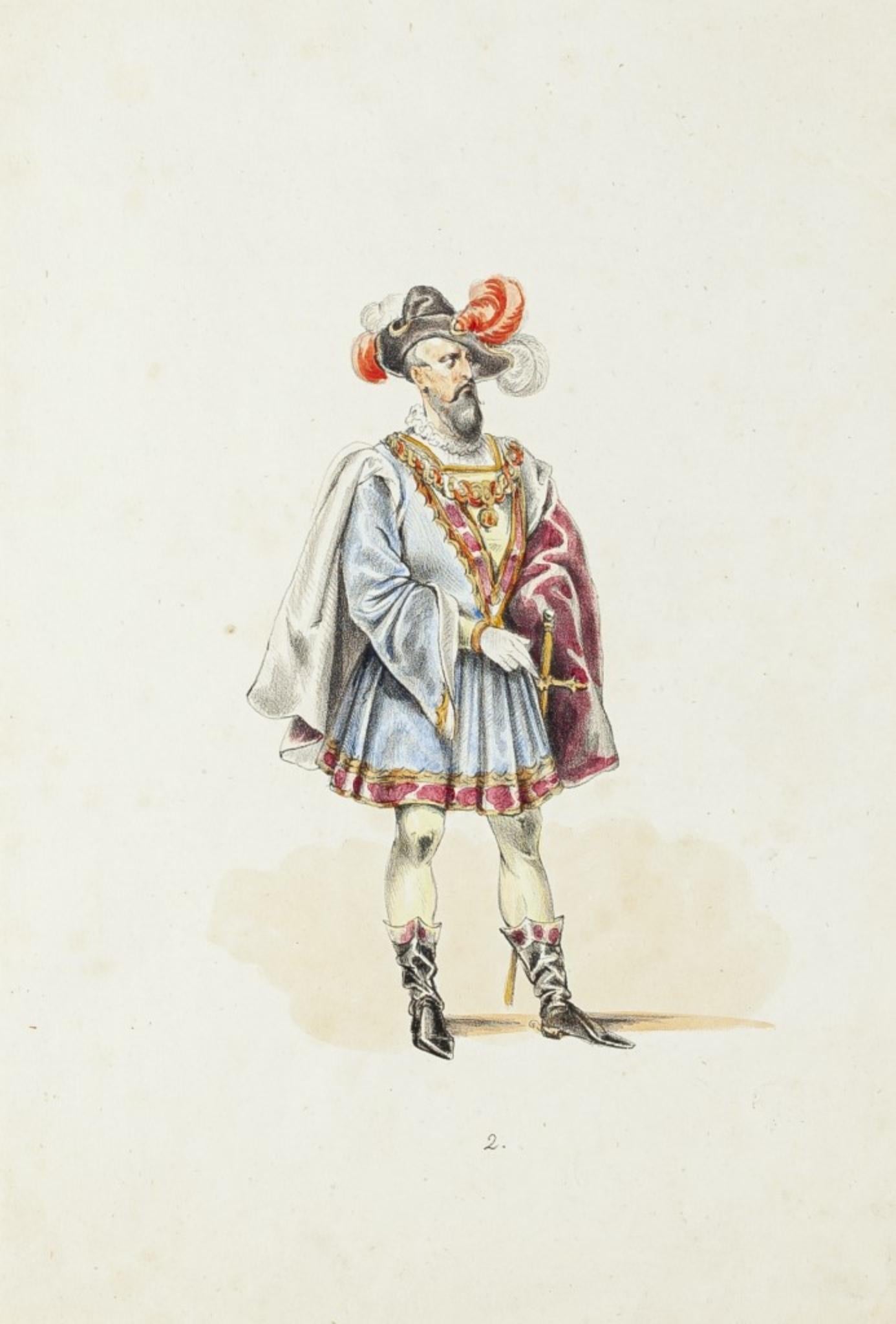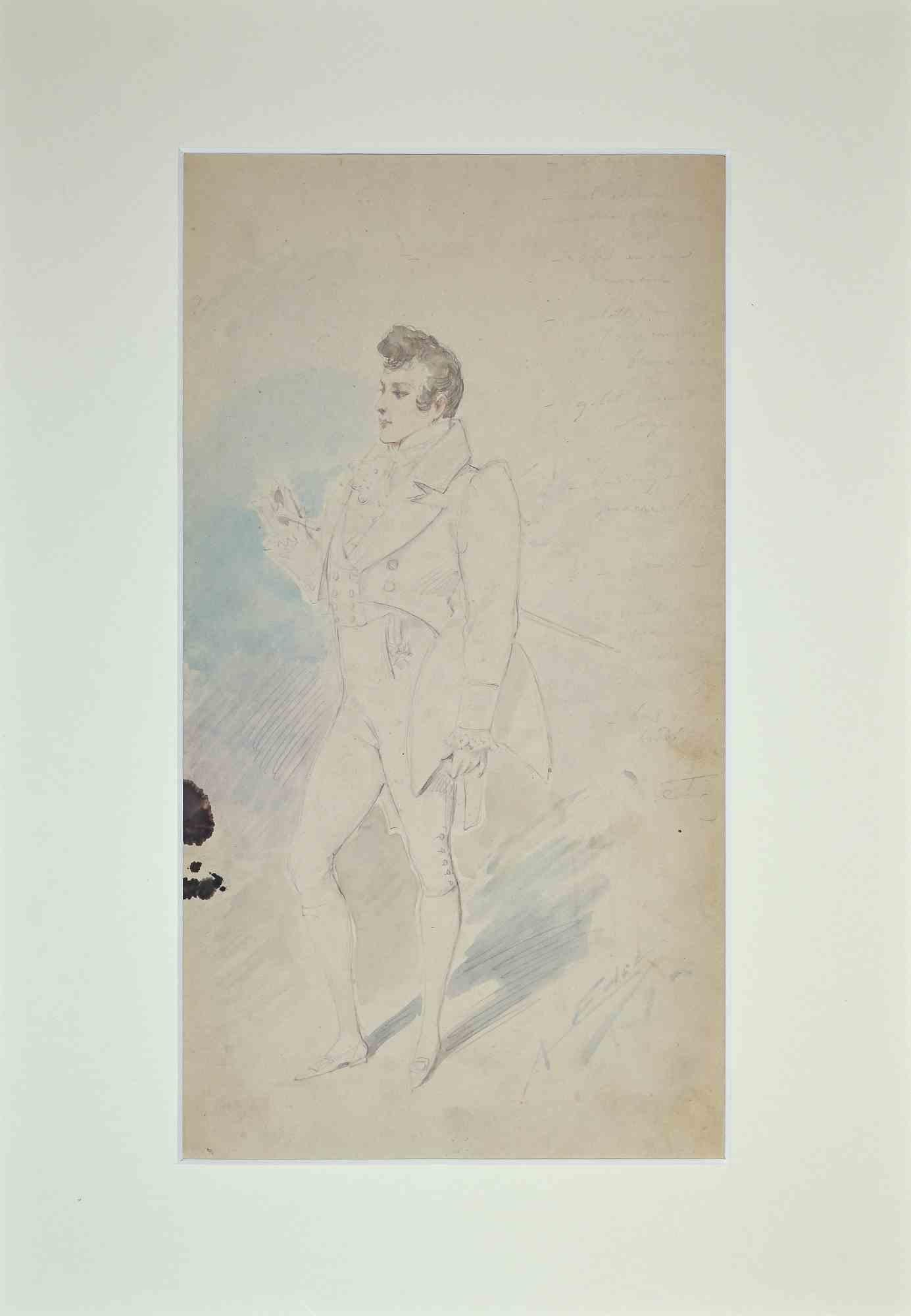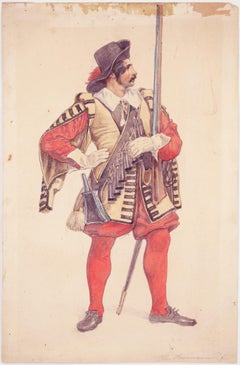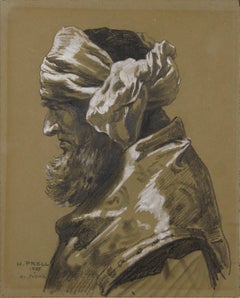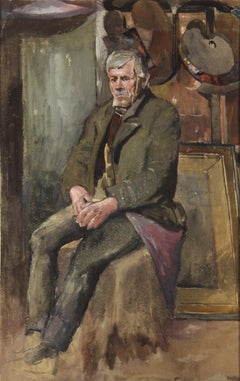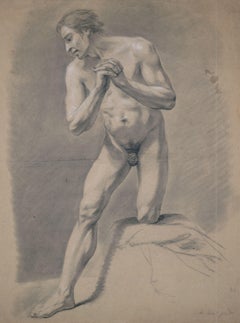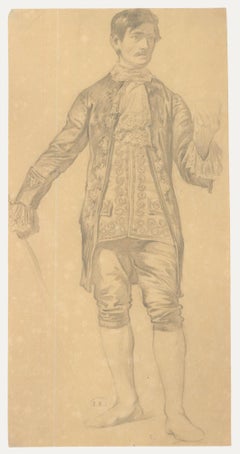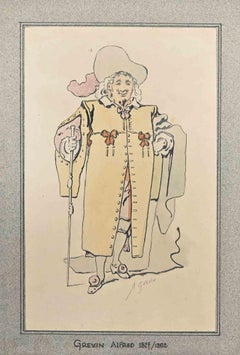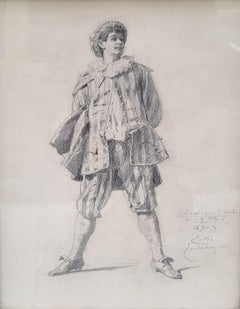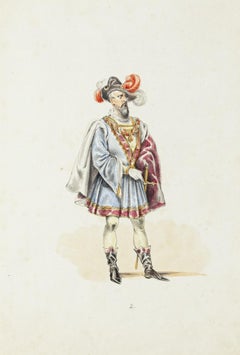Items Similar to The actor Karl Seydelmann, probably as Max Piccolomini / - Theatrical Realism -
Want more images or videos?
Request additional images or videos from the seller
1 of 4
Theodor HosemannThe actor Karl Seydelmann, probably as Max Piccolomini / - Theatrical Realism -c. 1840
c. 1840
$692.73
£515.09
€580
CA$972.97
A$1,071.17
CHF 547.48
MX$12,784.68
NOK 6,970.55
SEK 6,522.88
DKK 4,418.91
About the Item
Theodor Hosemann (1807 Brandenburg - 1875 Berlin), The actor Karl Seydelmann probably as Max Piccolomini, around 1840. Watercolor with pencil, 20.5 cm (height) x 14.7 cm (width), signed “Hosemann.” in pencil lower right.
- Paper somewhat darkened, dusty and with slight creases, mounting remnants on the reverse. The image itself in vibrant colors and good condition.
- Theatrical Realism -
The drawing is illustrated in the series "Kunst und Künstler" published by Bruno Cassirer in 1925 (vol. XXIII, no. 2, p. 49), where it is identified as a portrait of the actor Karl Seydelmann, probably playing Max Piccolomini from Friedrich Schiller's "Wallenstein". Parallel to Hosemann's realistic art, Seydelmann's expressive performances had helped the art of realistic acting to its breakthrough in Germany. From 1838 until his untimely death in 1843, Seydelmann was employed as a court actor in Berlin.
Hosemann shows the actor portraying Max Piccolomini wearing a balaclava and armor. Standing in contrapposto, leaning on his sword, Max Piccolomini appears as a powerful figure who is not at peace with himself, but remains in place because of a fateful decision to be made. His inner turmoil is expressed by the opposing directions of his gaze and his hand, illustrating the question ultimately directed at himself: "Should I really do this? The inner dilemma is made particularly vivid by the fact that the gestures do not get out of hand in baroque theatricality, but are kept in simple everydayness. This reveals the "new realism" that unites Seydelmann's play with Hosemann's art. The mastery of Hosemann's expressive realism is concentrated in the 'speaking' physiognomy.
About the artist
Theodor Hosemann worked for the "Lithografische Anstalt Arnz & Winckelmann" in Düsseldorf from 1819 until he was twelve years old. From 1822 to 1828 he also studied at the Düsseldorf Academy of Art, where he was a pupil of Wilhelm Schadow from 1826. In 1828, Johann Christian Winckelmann separated from his business partners, the brothers Heinrich and Josef Arnz, and opened the publishing house "Winckelmann & Söhne" in Berlin, specializing in picture and children's books. Theodor Hosemann followed Winckelmann to Berlin as an illustrator for the publisher, where he quickly made a name for himself and also worked for George Gropius' "Bunte Hefte" from 1830. From 1834 to 1852 he worked with the sharp-tongued humorist Adolf Glaßbrenner, who published under the name Adolf Brennglas, and created illustrations for his series "Berlin, wie es ist und - trinkt" (Berlin, as it is and - drinks), "Berliner Volksleben" (Berlin People's Life), and "Komischer Volkskalender" (Comic People's Calendar). From 1842 to 1855 Hosemann was a member of the renowned Berlin literary society "Tunnel über der Spree", where he was known as "[William] Hogarth" for his now mainly humorous illustrations. In 1857 Hosemann was appointed professor at the Berlin Academy, where Heinrich Zille was one of his students in 1874.
Theodor Hosemann's oeuvre includes numerous drawings and about 6000 graphic works. He also worked as a painter. His most important book illustrations include the writings of E.T.A. Hoffmann, the fairy tales of Hans-Christian Andersen, and the adventures of Baron Münchhausen.
"Pre-march Berlin found in him its most faithful chronicler and illustrator; and if he had not created more than his pictures of Berlin folk life, his memory could not be extinguished, and anyone who wants to understand the history of our city in those years must also have Hosemann's depictions at hand - the best pictorial chronicle of those years!
Publications of the Society for the History of Berlin, September 1897
GERMAN VERSION
Theodor Hosemann (1807 Brandenburg - 1875 Berlin), Der Schauspieler Karl Seydelmann wohl als Max Piccolomini, um 1840. Aquarell mit Bleistift, 20,5 cm (Höhe) x 14,7 cm (Breite), rechts unten in Blei mit „Hosemann.“ signiert.
- Papier etwas nachgedunkelt, angestaubt und mit leichteren Knickspuren, rückseitige Montagereste. Die Darstellung selbst in kräftigen Farben und gutem Zustand.
- Theatralischer Realismus -
Die Zeichnung ist in der im Verlag Bruno Cassirer erschienenen Reihe „Kunst und Künstler“ des Jahres 1925 (Jg. XXIII, Heft 2, S. 49) abgebildet und wird dort als Darstellung des Schauspielers Karl Seydelmann ausgewiesen, der wohl Max Piccolomini aus Friedrich Schillers „Wallenstein“ spielt. Parallel zu Hosemanns realistischer Kunst hatte Seydelmann mit seinen ausdrucksstarken Auftritten der realistischen Schauspielkunst in Deutschland zum Durchbruch verholfen. Von 1838 bis zu seinem frühen Tod im Jahre 1843 war Seydelmann als Hofschauspieler in Berlin engagiert.
Hosemann zeigt den Max Piccolomini verkörpernden Schauspieler mit Sturmhaube und in Harnisch gerüstet. Auf seinen Degen gestützt im Kontrapost dastehend erscheint Max Piccolomini als machvolle Gestalt, die allerdings nicht in sich ruht, sondern aufgrund einer zu treffenden Schicksalsentscheidung verharrt. Die innere Zerrissenheit kommt durch die gegensätzliche Ausrichtung des Blicks und der Hand zum Ausdruck, wodurch die letztlich an sich selbst gerichtete Frage, ‚Soll ich dies wirklich tun?‘, veranschaulicht wird. Das innere Dilemma wird besonders eindringlich präsent, indem die Gesten nicht in barocker Theatralik ausufern, sondern in einfacher Alltäglichkeit gehalten sind. Hierin zeigt sich der ‚neue Realismus‘, der Seydelmanns Spiel mit Hosemanns Kunst verbindet. Die Meisterschaft von Hosemanns ausdrucksstarkem Realismus konzentriert sich in der ‚sprechenden‘ Physiognomie.
zum Künstler
Bereits als Zwölfjähriger war Theodor Hosemann ab 1819 für die „Lithografische Anstalt Arnz & Winckelmann“ in Düsseldorf tätig. Von 1822 bis 1828 studierte er zudem an der Düsseldorfer Kunstakademie und war dort ab 1826 Schüler Wilhelm Schadows. 1828 trennte sich Johann Christian Winckelmann von seinen Geschäftspartnern, den Brüdern Heinrich und Josef Arnz, und eröffnete in Berlin den auf Bilderbögen und Kinderbücher spezialisierten Verlag „Winckelmann & Söhne“. Theodor Hosemann folgte Winckelmann als Verlagszeichner nach Berlin, wo er sich schnell einen Namen machte und ab 1830 auch für George Gropius „Bunte Hefte“ tätig war. Von 1834 bis 1852 arbeitete er mit dem scharfzüngigen Humoristen Adolf Glaßbrenner zusammen, der seine Publikationen unter dem Namen Adolf Brennglas veröffentlichte, und schuf Illustrationen für dessen Reihe „Berlin wie es ist und – trinkt“, das „Berliner Volksleben“ und den „Komischen Volkskalender“. Von 1842 bis 1855 war Hosemann Mitglied des renommierten Berliner Literatenvereins „Tunnel über der Spree“, wo er aufgrund seiner nunmehr vor allem humoristischen Bilden den Vereinsnamen „[William] Hogarth“ trug. 1857 wurde Hosemann als Professor an die Berliner Akademie berufen, wo 1874 Heinrich Zille zu seinen Schülern gehörte.
Theodor Hosemanns Oeuvre umfasst zahlreiche Zeichnungen und etwa 6000 graphische Werke. Darüber hinaus war er auch als Maler tätig. Zu seinen bedeutendsten Buchillustrationen zählen die Schriften E. T. A. Hoffmanns, die Märchen Hans-Christian Andersens und die Abenteuer des Baron Münchhausen.
„Das vormärzliche Berlin hat in ihm seinen getreuesten Chronisten und Schilderer gefunden; und hätte er nicht mehr geschaffen als seine Bilder aus dem Berliner Volksleben, sein Andenken könnte nicht verlöschen, und jeder, der die Geschichte unserer Stadt in jenen Zeiten recht verstehen will, muß auch die Schilderungen Hosemanns zur Hand nehmen – die beste Bilderchronik jener Jahre!“
Schriften des Vereins für die Geschichte Berlins, September 1897

About the Seller
5.0
Vetted Professional Seller
Every seller passes strict standards for authenticity and reliability
Established in 2014
1stDibs seller since 2023
21 sales on 1stDibs
- ShippingRetrieving quote...Shipping from: Berlin, Germany
- Return Policy
Authenticity Guarantee
In the unlikely event there’s an issue with an item’s authenticity, contact us within 1 year for a full refund. DetailsMoney-Back Guarantee
If your item is not as described, is damaged in transit, or does not arrive, contact us within 7 days for a full refund. Details24-Hour Cancellation
You have a 24-hour grace period in which to reconsider your purchase, with no questions asked.Vetted Professional Sellers
Our world-class sellers must adhere to strict standards for service and quality, maintaining the integrity of our listings.Price-Match Guarantee
If you find that a seller listed the same item for a lower price elsewhere, we’ll match it.Trusted Global Delivery
Our best-in-class carrier network provides specialized shipping options worldwide, including custom delivery.More From This Seller
View AllThe actor Karl Seydelmann as soldier / - The expressiveness of a simple pose -
Located in Berlin, DE
Theodor Hosemann (1807 Brandenburg - 1875 Berlin), The actor Karl Seydelmann as soldier, around 1840. Watercolor in pencil, 22 cm (height) x 14.7 cm (width), signed “Th.[eodor] Hosem...
Category
1840s Realist Figurative Drawings and Watercolors
Materials
Paper
Half-length portrait of a Pharisee - In the shadow of betrayal -
Located in Berlin, DE
Hermann Prell (1854 Leipzig - 1922 Dresden-Loschwitz). Half-length portrait of a Pharisee, 1885. Sketch for the right-hand figure in the painting Judas Iscariot, 1886. Pencil drawing heightened with opaque white and black chalk on beige-grey wove paper (papier vélin), 34 x 27.8 cm (visible size), 52 x 45 cm (mount), signed, dated and inscribed "H. PRELL 1885 zu 'Judas'".
Minor browning, collection stamp on the reverse.
- In the shadow of betrayal -
About the artwork
This painting is the sketch for the head of the Pharisee offering the coins to Judas in one of Herrmann Prell's major works, the painting Betrayal of Judas, completed in 1886. The painting belongs to the Staatliche Kunstsammlungen Dresden and is illustrated in Adolf Rosenberg: Prell, Bielefeld and Leipzig 1901, p. 21 (Fig. 19). It is especially highlighted in Thieme-Becker (vol. 27, p. 376).
Hermann Prell, Betrayal of Judas, 1886
The monumental head, which fills the picture and is distinguished by its ornamented robe, is almost a lost profile, which in the executed painting is justified by the Pharisee's turning towards Judas. Despite the fact that the sitter withdraws from the viewer by turning away, it was necessary to artistically elaborate the motivation for the purchase of one of Christ's disciples, which is why the drawing focuses on the expression of the face, while the 'accessories' are treated in a more summary manner.
In characterising the face, Hermann Prell performs a balancing act: since the Pharisee, despite his destructive actions, is an actor in the history of salvation, the head must show a dignity appropriate to the event, but at the same time the physiognomy must also bear witness to the scheming attitude that led to the betrayal. To solve this dilemma, Prell draws on the traditional depictions of the heads of the apostles, shading the face to indicate the obdurate darkness of the spirit and moving the base of the nose slightly upwards while the mouth falls away, thus giving a physiognomic expression to the motivation of the action. The fatal drama of the betrayal is expressed in the monumentalisation of the head and in the thunderous white highlights that contrast with the darkness of the chalk.
As a study, considered by the artist to be a work in itself, this drawing reveals the pictorial problems and brainstorming of monumental painting.
About the artist
In 1872 Prell, who was one of the most important exponents of monumental painting of his time, began studying painting with Theodor Grosse at the Dresden Academy of Art and continued with Carl Gussow at the Berlin Academy in 1876. Hans von Marées taught him in Rome in 1878. More influential on his work, however, were Arnold Böcklin and Max Klinger, with whom Prell had been friends since his student days and with whom he worked together on several occasions.
Prell's first major work, which established his reputation as a monumental painter, were the frescoes in the banqueting hall of the Architektenhaus in Berlin in 1881/82, commissioned by the state and depicting the different periods of architecture. Prell then went to Italy for two years to study fresco painting. Other major commissions followed. These included monumental frescoes in the town halls of Worms (1884), Hildesheim (1882-92), Gdansk (1895) and Dresden, the staircase of the Silesian Museum of Fine Arts in Breslau (1893/94), the throne room of the German Embassy in Rome (1896-99) and the staircase of the Albertinum in Dresden (1900-1904).
From 1886 Prell taught at the academy of arts in Berlin and in 1892 he was appointed professor at the academy of arts in Dresden. His students included Osmar Schindler and Hans Unger...
Category
1880s Realist Figurative Drawings and Watercolors
Materials
Chalk
$1,433 Sale Price
20% Off
Man sitting in the studio - Thinking about art -
Located in Berlin, DE
Adolph Eduard Otto von Faber du Faur (1828 Ludwigsburg - 1901 Munich). Man sitting in the studio. Watercolour painting, 43 x 27 cm (visible size), 73 x 53 cm (frame), monogrammed at lower right, estate stamp.
Upper right corner neatly repaired, small tear in the wall to the left of the sitter.
- Thinking about art -
About the artwork
The sitter, an elderly man, is seated in a studio on a pedestal reminiscent of an academy hall. The earthy, dark tones give the scene a weighty quality. The lightest tones are found in the incarnate parts of the figure, which do not stand out from the other colours of the picture, but are linked to them. As a result, the sitter's face is both part of and the highlight of the colour references in the picture. The colour of the sitter's skin is reflected in his pink coat, while his white-grey hair matches the colour of the wall next to him. This almost monochrome wall surface, in turn, is connected across the portrait to the framed picture standing on the floor, which seems to have been erased by this correspondence with the empty wall surface. Through the palette, which is positioned directly behind the sitter's head, the reference to painting, which is already given by the studio space, is explicitly linked to the sitter, who thus seems to be contemplating the question of the meaning of art.
This raises the question of whether Faber Du Faur, who had become lonely in his old age, might have painted a self-portrait here in his later years. In addition to the studio setting, the sitter's explicit reference to the palette and the fact that the picture was part of his estate, the only summary elaboration of the body suggests a self-portrait, while the representation of the face is concretised with the wide-open eyes typical of a self-portrait. This concentration on the face gives the impression of the artist's melancholy introspection, captured by the palette and related to the meaning of painting, whose dark character is reinforced by the concealment of the palette hanging on the right of the picture in the light tones so characteristic of Faber Du Faur. In the course of this resignation, Faber du Faur advises his son Hans, who has also become a painter: "Promise me one thing: never move to Munich, they'll kill you here!"
Whoever the sitter may be, the references to painting make the portrait a resigned self-contemplation by Faber Du Faur, focused on art.
About the artist
After leaving school, Otto Faber du Faur entered the service of the Württemberg army, at the same time cultivating his artistic talent. In 1851, on the recommendation of his father Christian Wilhelm, who was himself a battle painter, he spent six months in Munich as an apprentice to Alexander von Kotzebue. In 1852 he was granted a year's leave of absence from military service to study battle painting in the studio of Adolphe Yvon...
Category
1890s Realist Portrait Drawings and Watercolors
Materials
Watercolor
$907 Sale Price
20% Off
Male Nude / - The Drama of the Nude -
Located in Berlin, DE
Johann Heinrich Meil (1730 Gotha - 1820 Berlin), Male Nude, 1807. White heightened, occasionally wiped charcoal drawing on brownish paper, 51 cm x 39.5 cm, signed “J.[ohann] H.[einri...
Category
Early 19th Century Rococo Nude Drawings and Watercolors
Materials
Paper
General Wilhelm von Blume - Visionary retrospective -
Located in Berlin, DE
Bernhard Pankok (1872 Münster - 1943 Baierbrunn), General Wilhelm von Blume, 1915, aquatint etching, 34 x 29.5 cm (sheet size), 26 x 22 cm (plate size), signed in the plate at upper left, in pencil at lower right and dated in pencil at lower left.
- At lower left old collection stamp, at the right broad margin with a small spot, otherwise very good condition.
About the artwork
The 1915 aquatint etching of General Wilhelm von Blume is based on a 1912 oil painting in the LWL-Museum für Kunst und Kultur in Münster. A second oil portrait of the general by Pankok is in the Staatsgalerie Stuttgart. When Pankok painted the first oil portrait in 1912, the general had already been retired for 16 years. It is therefore a retrospective portrait. Accordingly, the orientation of his head is such that he is looking back in both the oil painting and the etching. Without fixing on anything in particular, he looks thoughtfully inwards and reflects on his life. Uniformed and highly endowed, it is his military activities in particular that he is reviewing attentively and, as his gaze reveals, quite critically.
Pankok has literally written the sum of his experiences on Wilhelm von Blume's face: The physiognomy is a veritable landscape of folds, furrows, ridges and gullies, all the more striking against the flat background. It is clear that each of the medals was also won through suffering. However, by breaking the boundaries of the picture, his bust appears as an unshakable massif, which gives the general a stoic quality.
The fact that the design of the portrait was important to Pankok can be seen from the different versions, the present sheet being the third and probably final revision, which Pankok dates precisely to 18 February 1915. Compared with the previous state, the light background now has a dark area against which the sitter's face stands out, the dark background in turn combining with the uniform to create a new tension in the picture.
Pankok's taking up of the portrait of the high-ranking military veteran and its graphic reproduction can also be seen in relation to the First World War, which had broken out in the meantime. In the face of modern weapons of mass destruction, Wilhelm von Blume's warfare and military writings were relics of a bygone, more value-oriented era.
About the artist
After studying at the Düsseldorf Art Academy from 1889 to 1891 under Heinrich Lauenstein, Adolf Schill, Hugo Crola, and Peter Janssen the Elder, Bernhard Pankok went to Munich in 1892, where he worked primarily as a graphic artist for the two major Jugendstil magazines "Pan" and "Jugend," which established his artistic success. Through this work he met Emil Orlik, with whom he had a lifelong friendship.
In 1897, he exhibited his first furniture, and in 1898, together with Richard Riemerschmid, Bruno Paul and Hermann Obrist...
Category
1910s Realist Portrait Prints
Materials
Etching
$458 Sale Price
20% Off
Balaclava - The target in sight -
Located in Berlin, DE
Heinrich Haberl (1869 Passau to 1934 Munich), Sturmhaube, c. 1900. drypoint, 14 x 10 cm (platemark), 28 x 21 cm (sheet size), 39 x 29 cm (passe-partout), titled "Sturmhaube" in lead at lower left and inscribed "Kaltnadelradierung", signed and locally inscribed "Heinrich Haberl Mchn. [Munich]" at lower right, inscribed again in lead on verso and with old collection stamp.
- slightly darkened, fixed and mounted
- The target in sight -
About the artwork
The theatrical "role-portrait" is to be seen against the background of the Rembrandt cult, which reached its climax at the end of the 19th century. The soldier seems to have stepped straight out of Rembrandt's Night Watch (1642) to fix something outside the picture with an alert and ready gaze. The steeply rising brim of the morion frames the gaze and thus perspectivises it as the actual 'pictorial action'. The gaze represents both the vigilant defence and the visionary goal of the battle.
Not only the subject, but also the style of the etching needle reflect Rembrandt's understanding of the times. Strong contrasts of light and dark are created in a virtuoso free stroke, without losing the effect of the reflections on the helmet and in the eyes. This shows a kinship with the early prints of Lovis Corinth, who also saw himself as an artist in the role of the knight. Against this background, Haberl's picture can also be seen as a representation of his artistic self-image.
About the artist
Heinrich Haberl first attended the art school in Nuremberg and from 1892 studied at the Munich Academy. There he was a master student of Johann Leonhard von Raab, Rudolf von Seitz, Franz von Defregger...
Category
Early 19th Century Realist Figurative Prints
Materials
Etching
$229 Sale Price
20% Off
You May Also Like
Edward Ridley (1883-1946) - Early 20th Century Graphite Drawing, The Actor
Located in Corsham, GB
A refined study by the artist Edward Ridley (1883-1946) depicting a gentleman dressed in theatrical clothing. Signed verso. 'E.S.K' blindstamped. On paper.
Category
20th Century Figurative Drawings and Watercolors
Materials
Graphite
Portrait of Gentleman - Drawing by Alfred Grevin - Late 19th Century
By Alfred Grevin
Located in Roma, IT
Portrait of Gentleman is a drawing in Pencil, Charcoal, and watercolor realized by Alfred Grévin in the late 19th Century.
Applied on a Passeprtout.
Hand-signed in pencil
In good ...
Category
Late 19th Century Modern Figurative Drawings and Watercolors
Materials
Pencil
French Drawing Portrait
Located in PARIS, FR
Emile BAYARD
La Ferté-sous-Jouarre, 1837 – Cairo, 1891
Portrait of the young Charles Baret in 1879
Black chalk drawing
34 x 28 cm (43 x 36 cm with frame)
Signed and dated lower left ...
Category
1870s French School Portrait Paintings
Materials
Carbon Pencil
Theatrical Costume - Original Lithograph - Early 20th Century
Located in Roma, IT
Theatrical Costume is a splendid hand lithograph engraved by Anonymous Artist in the Early XX Century.
The state of preservation of the artwork is exc...
Category
Early 20th Century Modern Figurative Prints
Materials
Lithograph
Theatrical Costume - Pencil Drawing by Alfredo Edel - 1895
By Alfredo Edel
Located in Roma, IT
Theatrical Costume is an original pencil, pastel and watercolor drawing realized by Alfredo Edel in 1895.
Good condition, the artwork is with watercolor and biacca.
Hand signed with pencil by the artis.
Alfredo Leonardo Edel (1856–1912), sometimes credited as Alfredo Edel Colorno, was an Italian costume designer popular during the late 19th and early 20th century. He worked at the La Scala opera...
Category
1890s Old Masters Figurative Drawings and Watercolors
Materials
Pencil, Pastel, Watercolor
Paysan Centenaire, Soldat de l'Armée du Général Kosenisko by Franciszek Tepa
By Franciszek Tepa
Located in London, GB
SOLD UNFRAMED
Paysan Centenaire, Soldat de l'Armée du Général Kosenisko by Franciszek Tepa (1829-1889)
Watercolour
26.3 x 30 cm (10 ⅜ x 11 ¾ inches)
Initialed and dated lower left, ...
Category
1870s Realist Portrait Drawings and Watercolors
Materials
Watercolor
